Strings and Spin:
Applying What We Know About Copoly
Joshua Speckman
In the first article in this series on strings and spin, we learned that slippery strings, like copoly, generate extra spin because the main strings slide, stretch and snapback, applying an extra spin-boosting torque on the ball. (Click Here.)
In the second article, we saw how copoly strings are actually similar to their ancestor from the 1970s, spaghetti strings. Both technologies use the same sliding and snapback mechanism to give players more spin. (Click Here.)
But what does this mean for you? In this third article, let's go over some of the ways copoly strings are used in pro tennis, see what the applications are at other levels, then suggest a few new ground rules for equipment selection and care.
It's important to emphasize at the start that the most important factors for spin generation remain racket head speed and swing angle. To generate more spin, the most important thing to address is technique.
"If you want more spin the first thing you need to do is hit the ball harder," says tennis physicist Rod Cross. "The second thing is to hit at a steeper angle.
"The third thing is to tilt the racket head forward a little bit, and that's something that I don't think a lot of coaches know about, that if you tilt the racket you'll get more spin.
"Now the next thing you do is eat and sleep better and go to the gym more so you can hit harder. And then the fifth thing you do is change from nylon to polyester."
Despite the average player's desire for a magic bullet, copoly simply won't substitute for the other factors that go into generating more spin. But with nearly every ATP pro now using copoly strings, more and more recreational players who want to take part in the game's evolution are jumping on the copoly bandwagon.
Many professional stringers, however, steer their amateur clients clear of copoly strings because they are so stiff. This stiffness is one of the reasons why they snapback and produce spin so well, but it also makes them hard on the arm.

|
The copoly recipe: string loose, swing hard, and impart more spin. |
One safer option with copoly (especially for young juniors who insist on using it) is to string at much lower tensions than most players have ever considered. Manufacturers routinely advise tensioning copoly 10% lower than nylon (multifilament or syngut) strings. But ATP pros often go lower than that.
"For my clientele, which is almost exclusively pro players, they can string it loose, swing hard, and impart more spin without losing control," says Nate Ferguson, the personal stringer of Roger Federer, Novak Djokovic and Andy Murray. "They string in the 40s and low 50s; really loose tension, which was unheard of ten years ago."
But in the United States, in particular, there seems to be a fondness for "crisp" stringbeds and high tensions. Perhaps this has something to do with Pete Sampras, who famously had Ferguson string his 85 square inch rackets with natural gut at 75 pounds.
The drum-tight string bed helped Pete with control, but most players don't realize that natural gut is unique among strings in that its stiffness does not increase appreciably at higher tensions. Natural gut at 75 pounds is only slightly stiffer than natural gut strung at 50 pounds.
But nylon and copoly don't share this characteristic - the tighter they are strung the stiffer they become - so dropping tension can dramatically improve comfort with these materials. An arm-killing copoly at 60 pounds will feel rather soft at 40 pounds.

|
Pete in the old days: 85 square inch racket, gut at 75 pounds. |
In fact, a copoly like Luxilon Alu Power at 35 pounds is about as stiff, and transfers as much shock, as nylon strung at 55. But even at those tensions both materials are still stiffer than Pete's gut at 75 pounds.
Surprisingly, anecdotal reports from players suggest that copoly strung at 30, 20, even 10 pounds of tension, can, depending on the player, result in more spin, power and feel than at higher tensions, with surprisingly little loss of control.
Nate Ferguson notes that Italian pro Fillipo Volandri strings his racket with copoly strings at 26 pounds, and sometimes drops to around 19 when playing on clay. Volandri beat Federer in Hamburg several years ago playing at these super-low tensions.
"Poly has evolved," Ferguson says, "and now these guys who love the spin...they can lower the tension because the ball's not going to fly off. You're getting that cupping feeling, you're getting the feeling of more control, even though you're going looser."

|
The Italian player Fillipo Volandri strings with poly at 19 pounds on clay. |
Another way to take advantage of the copoly spin boost, but with more comfort, feel and power is to hybrid with nylon or natural gut. Roger Federer has been using natural gut mains and Luxilon Alu Power Rough crosses since prior to hiring Nate Ferguson in 2004.
Federer is one of the few pros today that played with full natural gut for a significant part of his career. He was pretty good with it too, beating Sampras at Wimbledon in 2001 with a full bed of gut. So why did he add copoly strings to the mix?
"Spin control," answers Ferguson. "Spin is part of control, and he gains both. Definitely more spin, and with that comes control. And with that control he can string way down low. He strings at 21.5 or 22 kilos (47 or 48.5 pounds)," he adds.
Federer's setup actually bears some resemblance to spaghetti strings, as that invention also used natural gut in the mains and a synthetic in the crosses. Many players find the combination of extremely elastic gut mains with stiff, hard and slick copoly crosses to be as, or more, spin-friendly than a full bed of copoly, while also being more comfortable, powerful and giving better feel for the ball.
In string-on-string friction tests, tennis equipment researcher Crawford Lindsey found that gut mains slide with less friction along copoly crosses than any other string or string combination. And he found that - unlike other strings, where notching ramps up friction and disables the snapback mechanism - inter-string friction actually gets lower as the notches get deeper.
Why? Lindsey and Cross speculate that natural oils seep out of the gut at the notches and lubricate the string intersections. This suggests that a gut/poly hybrid might retain its spin-generating potential for longer than any other string or combination. Well, at least until the gut breaks.
Surprisingly, the opposite configuration - poly mains/gut crosses - slides much less easily. Lindsey says the two materials are sticky in reverse perhaps because the surface of the gut crosses quickly abrades, pulling up microscopic fibers that get hung up on the copoly mains as they try to slide.
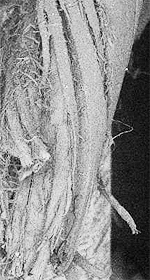
|
Natural gut magnified 25 times. |
The reason poly strings initially became popular with professional players was because of their inherent durability. Although modern copolymer strings are softer than "1st generation" polyester strings, they are still stiffer and harder than nylon or gut, and typically take longer to notch and break.
But, on the other hand, one well-known drawback of copoly strings is that they lose much more tension than gut and nylon. Consequently, advanced players often cut them out when they start losing control, saying they've "gone dead."
This is often assumed to be due to loss of resiliency. But lab tests show that strings don't really lose elasticity as they lose tension, which means that they should actually become more lively with tension loss.
The loss of depth control experienced with a well-played copoly could also be attributed to string wear resulting in impairment of the snapback mechanism. Werner Fischer, the inventor of spaghetti strings, points out that, although copoly is harder than nylon or gut, the surface of the strings can still becomes worn, roughened and notched over time, particularly if playing on clay.
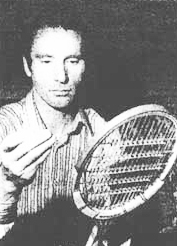
|
Werner Fischer, the inventor of spaghetti strings, notes copoly can still becomes worn, roughened and notched over time. |
"Once a polyester string reaches a certain amount of playing time, the main strings lose their gliding ability, so that the mechanism does not work as well, or stops working completely," Fischer explains. "The [spin-boosting] effect works only as long as the strings are relatively new." Having lost the downward diving spin of their copoly strings when new, players may suddenly find the ball flying long.
For pros, this isn't a problem - they generally only play with new strings for several games or a set anyway - but for amateur players the premature loss of the snapback mechanism cancels out copoly's durability advantage.
As a general rule then, it would make sense for players to replace their copoly strings as soon they get stuck out of place, or begin to "move" in the parlance of players.
"The moment it goes out of line you've lost control. If the strings get stuck out wide you lose control and you lose spin as well," adds Barry Phillips-Moore, a former pro player and coach who played with spaghetti strings in the 70s and has been trying to recreate their effect ever since.
So can anything be done to keep the main strings sliding and snapping back longer?
Well, on clay courts, it might make sense to rotate rackets more frequently than normal during a match to minimize accelerated friction-wear from the dirt, and then wipe accumulated clay off the strings before playing again.

|
Rotating rackets more frequently may be important for copoly players. |
Fischer notes that plastics like copoly will also melt and notch due to heat from friction. So in practice sessions, where a player might hit many more balls in an hour than in an entire match, it might not be a crazy idea to again rotate rackets frequently to keep the strings from over-heating.
Although it is not widely available outside of Japan, the silicone-based lubricant called Mira-fit may also prolong or revive the snapback ability of worn and notched strings. In a recent experiment, Crawford Lindsey showed that the commonly available lubricant WD-40 both revives the spin potential of notched strings and improves the spin generated by new strings as well. And it should also reduce premature wear by reducing friction and heat. These lubricants are currently legal for tournament play.
Another factor to consider is thickness, or gauge. Traditionally, thin, high-gauge strings have been favored for feel and spin. But the old explanation - that the strings allowed the ball to bite deeper into the pattern, increasing friction - doesn't square with what science is telling us about strings and spin.
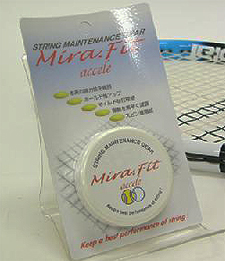
|
Lubricants such as Mira-Fit can increase, prolong, or revive copoly snap back ability. |
But once the link was made between slippery copoly and spaghetti strings, researchers began wondering how copoly strings could be freed to move with less friction and more freedom within the constraints of a woven stringbed. "Thick strings are maybe less slippery, because thick strings, when you weave them there's a bigger angle to the weave," says Cross.
"But if they were only one micron thick there would be hardly any distortion of the strings and they would slide sideways and come straight back." At the other extreme, he says, "if they were a half-inch thick they would be really locked in together."
At present there is, however, no objective evidence that thinner strings do give more spin. Players routinely report that they do, but determining whether they are correct will have to wait for more research.
Finally, what about the great variety of shaped or textured copolys on the market - all advertised as spin strings? Well, according to tennis scientists, because the stringbed is woven, with natural peaks and valleys, all strings have sufficient friction with the ball at most impact angles to generate spin. So, theoretically, any additional friction provided by rough or pentagonal strings shouldn't make any difference.
But subjective reports consistently contradict this. At one online string playtest database, 17 of the top 20 strings rated by players for spin were shaped or textured copolys. Remember, scientists originally dismissed the existence of the poly-spin effect, despite how obvious it was to the players. So perhaps it is a mistake to discount their perceptions again.
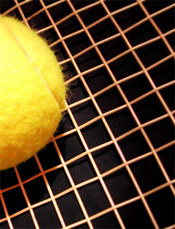
|
What is the real effect of thinner gauge? |
So what's going on here? Science is always a work in progress, and this is one area where more research needs to be done.
But so far, there are two possible explanations. First, Crawford Lindsey says that increased friction between the textured strings and the ball may play a role during the snapback phase.
We know that the ball must grip the main strings in order to slide and stretch them sideways. But once the main strings reverse direction and start snapping back, they have to re-grip the ball in order to apply spin-enhancing torque. If the strings can re-grip the ball quicker they can apply spin-enhancing torque for a slightly longer period of time. So it might be during the snapback phase that textured and shaped strings have an advantage.
However, Lindsey's recent experiments showed that lubricating strings increased the spin potential, across the range of string materials. A lubricant will reduce friction between strings, but also between the ball and the strings. So whatever role string-ball friction may have in spin generation, it is almost certainly less important than having the intersections between strings as slippery as possible.
Still, there is one scenario where a player would want the highest possible string-on-ball friction. On almost all shots, theory and lab tests agree that slippery strings, and rough or textured strings, both have plenty of friction to spin the ball.
But on extremely steep swings with the racquet moving very fast - a topspin lob or the heaviest Nadal forehands being good examples - the ball can actually slip off the strings instead of biting them. In this case, a really rough string produces more spin than a really slippery one.
In any case, it's important to note that greater friction generally only makes a difference in the interaction between the ball and the main strings. This is because it is the main strings that are gripping the ball, sliding and snapping back. The role of cross strings in the snapback mechanism is to act as stiff and slippery rails for the mains to glide and slide on.
So one way to possibly have your cake and eat it too is to use a smooth and slippery cross string paired with a slippery but textured main string, something that string manufacturers have realized. Several manufacturers now offer hybrid packages containing two half-sets: a textured copoly for the mains and a smooth copoly for the crosses.
But regardless of the potential of copoly strings, the big question is still: Is this stuff for everyone? For players who hit flat, don't break strings, have tender elbows, or feel they need more pop, natural gut remains the gold standard.
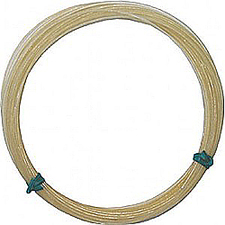 |
Natural gut remains popular on the women's tour. |
And according to Cross and Lindsey's tests, gut is pretty good at generating spin too: offering about 15% more than nylon. Gut remains popular on the WTA tour, where power and spin may be more valuable than spin alone. The Williams' sisters, along with Justine Henin (up until her 2nd retirement), continue to use gut, the string favored by pros for over a hundred years.
Syngut and multifilament strings, both made of nylon, don't spin the ball as well as copoly or gut. They are softer and more arm-friendly than copoly, but less powerful than natural gut. Many of them are also pretty cheap, and perfectly adequate for most recreational players. The biggest problem with them is that they must be straightened constantly.
And if spin isn't a huge feature of your game, does poly have any use? Quite possibly. For a player with conservative grips and/or traditional mechanics, an experiment with copoly might be worth a try, as the strings will give you more spin with the same swing and effort.
Nate Ferguson says that Pete Sampras, with his relatively flat, classical strokes, switched to Babolat RPM Blast last year and is enjoying the greater "spin control" on the senior tour.
One final thing to note is that lab results will not always be consistent with our on-court perceptions. Because each different string setup will launch the ball at a slightly different angle, and with slightly more or less speed than others, its very difficult to subjectively evaluate how much spin we're getting out in the real world.
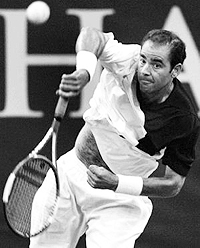
|
Even Sampras has switched to Babolat RPM Blast. |
Applying lubricant to strings is an extreme example of this. We know from lab tests that lubricant will increase spin considerably. But it will also raise the launch angle quite a bit as well. Consequently, out on the court we may find the ball going long, even with all the extra topspin we're getting. To compensate, we could flatten our swing slightly to lower the launch angle, but this will reduce the spin. Alternatively, we could close the racquet face slightly at impact. This will also lower the launch angle, but increase the spin.
We can adjust to a new string setup in different ways, but unless we know exactly which adjustments we're making it's very difficult to distinguish what we're doing from what the strings are doing.
Lab research is invaluable because it reveals what is really happening. But it's also limited because the player isn't in the lab. On-court results will always be the most important dataset in tennis.
Scientific research into strings has really raised our understanding of why some strings generate more spin than others. But as always, more knowledge leads to more questions. Crawford Lindsey and Rod Cross soon plan to answer some of them by comparing the spin potential of many more strings and combinations in direct head-to-head tests.
But for the individual player, at this point there are no simple prescriptions. Level, playing style, injury - not to mention the patience and cost involved in conducting your own experiments to chose the right string or string combo - all need to be considered when choosing which strings are right for you.
But one fact is indisputable. The copoly effect is real. And the practical applications of the slippery string theory will continue to be refined and evolve as researchers, manufacturers - and players--experiment with more and more variations.




